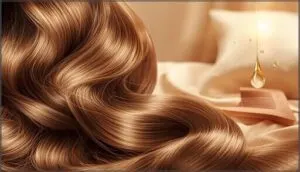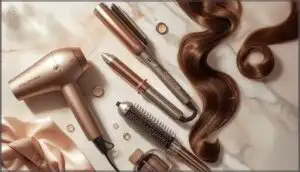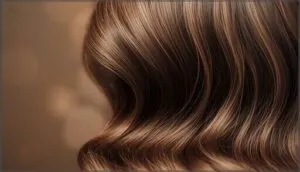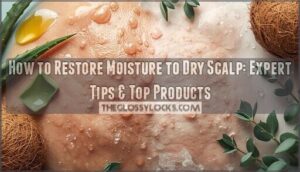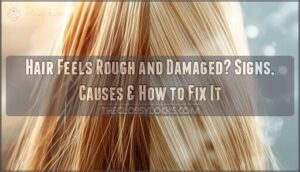This site is supported by our readers. We may earn a commission, at no cost to you, if you purchase through links.
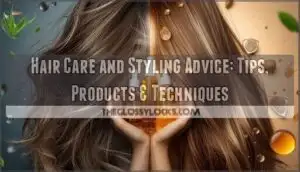 Most people treat their hair the same way every day, wondering why it won’t cooperate. Here’s the truth: hair isn’t one-size-fits-all, and what works for your friend’s sleek strands might wreck your curls.
Most people treat their hair the same way every day, wondering why it won’t cooperate. Here’s the truth: hair isn’t one-size-fits-all, and what works for your friend’s sleek strands might wreck your curls.
Your hair’s texture, porosity, and even how much oil your scalp produces all demand different approaches. Once you understand these factors, you’ll stop fighting your hair and start working with it.
The right techniques and products can transform your routine from guesswork into a system that actually works. Whether you’re battling frizz, flatness, or breakage, small adjustments in how you wash, style, and protect your hair make all the difference.
Table Of Contents
- Key Takeaways
- Essential Hair Care Tips for All Types
- Protecting Hair From Damage and Dryness
- Effective Hair Styling Advice and Techniques
- Maintaining Scalp Health and Hair Growth
- Top 10 Hair Care and Styling Products
- 1. RŌZ Foundation Shampoo Healthy Hair Formula
- 2. OUAI Detox Clarifying Shampoo Cleanse
- 3. Curlsmith Curl Quenching Conditioning Wash
- 4. VEGAMOUR GRO Scalp Detox Serum
- 5. Nécessaire Rosemary Hair Serum for Thinning
- 6. Nutrafol Women’s Hair Growth Serum
- 7. K18 Molecular Repair Hair Oil
- 8. Christophe Robin Prickly Pear Serum
- 9. Kerastase Overnight Hair Serum Dry Hair
- 10. Mizani Heat Protectant Spray for Hair
- Frequently Asked Questions (FAQs)
- Conclusion
Key Takeaways
- Your hair’s unique characteristics—texture, porosity, scalp oil production, and density—demand individualized care routines, meaning what works for someone else’s hair might actually damage yours.
- Proper washing and conditioning techniques matter more than product choice alone: focus shampoo on your scalp (not ends), condition from mid-lengths down, adjust washing frequency based on your scalp’s oil production, and always use heat protectants before styling to prevent irreversible damage.
- Scalp health directly determines hair growth and strength, so regular scalp care through exfoliation, massage, balanced nutrition (protein, omega-3s, iron), proper hydration, and quality sleep creates the foundation for healthy hair.
- Small adjustments like switching your hair part for volume, alternating between air drying and heat styling, rotating protective hairstyles to minimize strain, and using the right tools for your hair type transform your routine from guesswork into a system that actually works.
Essential Hair Care Tips for All Types
Taking care of your hair starts with understanding what it really needs. The basics matter more than you might think, and getting them right makes everything else easier.
Here’s what you need to know to build a solid routine that works for your unique hair.
Understanding Your Hair’s Unique Needs
Why does your hair act differently than your friend’s, even with the same products? It comes down to understanding hair needs like hair texture, hair porosity, scalp oil production, and hair density.
Hair texture ranges from fine to coarse, while porosity determines how your strands absorb moisture. Scalp oil varies by hair types—straight hair gets oilier faster than curly. Understanding hair porosity helps determine how well your hair retains moisture.
Individualized care based on these factors saves you time and frustration.
Proper Hair Washing Techniques
Once you know what makes your hair tick, the next step is washing it the right way—which isn’t as simple as lather, rinse, repeat. Getting your hair washing routine down pat means healthier strands and less product buildup. Here’s how to nail your hair care routine:
- Use lukewarm water temperature to protect natural oils
- Focus shampoo application directly on your scalp, not the ends
- Give yourself a gentle scalp massage to boost circulation
- Rinse thoroughly until water runs clear—no shortcuts
- Wash every 2-3 days unless your hair washing frequency needs differ
Washing hair correctly keeps your hair care tips working their best.
Conditioning Methods for Optimal Health
After you’ve got the washing part dialed in, conditioning is where you lock in moisture and keep your hair soft, manageable, and ready for whatever comes next. Apply conditioner from mid-lengths to ends—never the scalp.
Rinse-out types work daily, while leave-in benefits include extra hydration between washes. Deep conditioning and protein treatments rescue damaged strands when hair needs serious help.
Frequency of Hair Washing and Care
How often you wash your hair matters just as much as how you do it, and finding your ideal frequency depends on what your hair’s actually telling you. Daily washing works for oily scalps, but over-washing strips natural oils and dries everything out.
Most people do fine washing every two days, which keeps scalp health in check and prevents product buildup without compromising hair health.
Tailoring Routines for Texture and Lifestyle
Your hair’s texture and daily routine need to work together, not against each other, which means your washing schedule, product picks, and styling choices should feel like they actually fit your life. Fine hair needs lightweight styling products, while thick, coarse hair thrives with richer formulas.
Hair porosity affects how you layer products, and climate impact matters—humidity calls for different haircare routines than dry environments. Custom routines that match your hair type and lifestyle factors keep hair styling practical and effective.
Protecting Hair From Damage and Dryness
Your hair faces a lot of threats every day, from hot tools to harsh weather, and knowing how to shield it makes all the difference.
The right protection strategies can keep your strands strong, smooth, and healthy for the long haul.
Here’s what you need to focus on to prevent damage and keep dryness at bay.
Heat Damage Prevention Strategies
Heat styling can be like turning up a flame under your hair—temperatures above 175°C can literally create bubbles inside strands, weakening them from within. High heat can also lead to increased hair porosity, making it more susceptible to damage.
Temperature control is your first line of defense: keep tools between 150°C–180°C, limit each section to under 15 seconds, and reduce frequency to give hair recovery time. Mechanical management matters too—skip overlapping passes and detangle gently before styling. Material innovations like ceramic plates distribute heat more evenly, preventing hot spots that accelerate hair damage.
Using Heat Protectants and Thermal Sprays
Think of heat protectants as invisible armor that stands between your styling tools and the structural integrity of every strand. These thermal sprays create a protective barrier by coating hair with silicones or polymers that absorb and distribute heat more evenly.
Apply them to damp hair before blow-drying or on dry sections before flat irons and curlers—ingredient efficacy depends on proper application techniques, so don’t skip this step when heat styling.
Air Drying Vs. Heat Styling
Skipping the blow dryer might seem like the safer route, but the truth is that both air drying and heat styling come with their own sets of trade-offs. The key differences include:
- Drying Time: Air drying takes longer but eliminates direct heat exposure
- Hair Texture: Heat styling offers more control, while air drying works with your natural pattern
- Damage Levels: Prolonged wetness can weaken strands, but excessive heat styling causes cuticle damage
- Styling Options: Heat tools transform your look instantly; air drying requires styling products for definition
Your hair care routine should balance both methods based on your hair health goals.
Preventing Split Ends and Breakage
Split ends don’t just appear out of nowhere—they’re the final stage of a damage process that started weeks or even months earlier. Preventing hair breakage starts with gentle detangling from the ends up, regular hair trimming every six to eight weeks, and protective hairstyles that reduce friction.
Hydration is everything—pair protein treatments with deep conditioning to strengthen strands and keep split ends from climbing higher up your hair shaft.
Sun and Environmental Protection for Hair
Just like your skin, your hair takes a beating from UV rays, pollution, and even chlorine—but most people forget to protect it until the damage is already done. UV hair damage weakens strands and fades color, while pollution effects dry out your scalp.
Use hair sunscreen or leave-in sprays with SPF, wear protective hairstyles like braids, and don’t skip scalp sunscreen. Hydration importance doubles when you’re dealing with environmental factors—your hair needs that moisture barrier.
Effective Hair Styling Advice and Techniques
Getting your hair to look great isn’t about fancy tricks—it’s about using the right tools and techniques that work with your hair, not against it. The key is knowing which methods protect your strands while still giving you the style you want.
Let’s walk through some practical ways to style your hair that keep it healthy and looking its best.
Choosing The Right Styling Tools
Your styling tools can be the difference between a look that falls flat in an hour and one that actually lasts, so picking the right ones for your hair type matters more than you might think. Here’s what to look for:
- Material Matters – Ceramic blow dryers distribute heat evenly, while titanium works best for thick hair.
- Temperature Control – Adjustable settings prevent heat styling damage on delicate strands.
- Tool Adaptability – Multi-barrel curlers or interchangeable brush attachments save space and money.
- Ergonomic Design – Lightweight tools reduce arm fatigue during styling.
- Budget Considerations – Quality hair styling tools don’t always mean the priciest option.
Locking in Your Look With Hairspray
Once you’ve nailed the right tools, the secret to keeping that polished style from morning till night often comes down to one simple step: hairspray.
The right strength makes all the difference—light for touchable waves, strong for slicked-back styles that won’t budge. Look for hairspray ingredients that match your hair type, and apply in short bursts from about 10 inches away to avoid stiffness or buildup.
Switching Up Hair Parts for Volume
If you’re already locking down your style with hairspray, another quick trick to amp up volume is changing where you part your hair. Switching sides lifts roots naturally and creates instant fullness—no extra styling products needed.
Here are some parting volume tricks to try:
- Move your part every few days to prevent hair from getting too flat or comfortable in one spot
- Use a parting tool like a rattail comb to create clean lines that flatter face shape harmony
- Pair with root lift techniques by blow-drying against the grain for maximum height
This simple hair styling technique works with any hair texture.
Creating Styles That Minimize Hair Strain
While boosting volume is great, wearing your hair in super tight styles all the time can actually cause breakage and stress on your strands. That’s why gentle styling and hairstyle rotation matter.
Try protective hairstyles like loose braids or low buns, and swap out regular elastics for soft hair elastics. Avoiding tension means skipping hair slicked back styles that pull too hard.
Instead, focus on reducing breakage by alternating between wearing your hair down and in looser updos throughout the week.
Maintaining Scalp Health and Hair Growth
Your scalp is the foundation for everything that grows from it, so keeping it healthy isn’t optional if you want strong, vibrant hair. From nourishing treatments to the foods you eat, small adjustments can make a real difference in how your hair looks and feels.
Here’s what you need to focus on to support both scalp health and hair growth.
Importance of Regular Scalp Care
Think of your scalp as the soil where healthy hair grows—it needs the same attention and care you give the rest of your hair. Regular scalp care keeps things balanced and promotes stronger strands. Here’s what’s important:
- Scalp exfoliation removes product buildup and dead skin cells
- Massage benefits boost hair circulation and encourage growth
- Microbiome balance maintains your scalp’s natural defense system
- Oil production regulation prevents greasiness or dryness
- Scalp serum treatments nourish roots for better scalp health
Deep Conditioning and Leave-in Treatments
Deep conditioning and leave-in treatments act like a power meal for your hair, giving it the extra nourishment it needs to stay soft, strong, and healthy. Apply deep conditioners weekly based on your hair porosity, and use leave-in treatments daily for ongoing hair hydration and moisture.
Match treatment ingredients and application techniques to your hair’s unique needs for the best results.
| Treatment Type | Best For |
|---|---|
| Deep Conditioning Masks | Damaged, dry hair needing intense repair |
| Leave-In Conditioners | Daily hair moisture and detangling |
| Overnight Treatments | Maximum hair treatment absorption |
Nutrition and Lifestyle for Healthy Hair
What you eat shows up in your hair, so focus on protein-rich foods, omega-3s, and iron to support strong hair growth and prevent Dietary Deficiencies. Hair-Friendly Foods like leafy greens and salmon deliver essential hair nourishment, while regular exercise boosts circulation to your scalp.
Lifestyle Impacts matter too—stress, smoking, and poor sleep weaken hair, so manage Scalp Oil balance and consider Supplement Choices carefully, since high doses can backfire and trigger loss instead of healthy eating for hair results.
Addressing Dandruff and Scalp Issues
Dandruff affects around 50% of adults worldwide, driven by Dandruff Causes like Malassezia fungi on the Scalp Microbiome, stress, and diet.
Treatment Options include medicated shampoos with ketoconazole or zinc pyrithione—leave them on for five minutes to penetrate the scalp.
Lifestyle Factors matter: avoid overwashing, skip rubbing oil in (it worsens flaking), and consider Emerging Therapies like probiotic scalp serum formulas to restore balance and prevent hair loss.
Sleep and Hydration for Hair Wellness
Your hair’s best friend isn’t a fancy serum—it’s the water bottle on your nightstand and those seven hours you keep skipping. Proper Sleep Quality boosts Scalp Circulation and Nutrient Absorption, which directly fuels Hair Growth. Meanwhile, solid Hydration Levels keep strands flexible and strong.
Try a silk scarf or pillowcase for hair care at night—it reduces friction and locks in hair hydration while you rest.
Top 10 Hair Care and Styling Products
Now that you’ve got the basics down, let’s talk about the products that can really make a difference in your routine. The right shampoos, serums, and styling protectants can help you maintain healthy hair and achieve the looks you want.
Here are ten standout products that cover everything from scalp health to heat protection.
1. RŌZ Foundation Shampoo Healthy Hair Formula
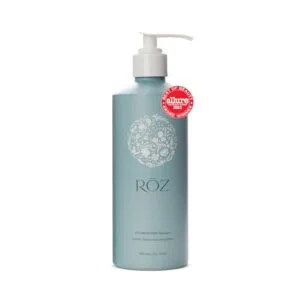
RŌZ Foundation Shampoo brings together science and nature to rebuild your hair from the ground up. The formula uses coconut-based surfactants and ceramides to cleanse gently while locking in moisture, making it ideal for anyone looking to restore scalp health without stripping color or natural oils.
With its BotaniComplex blend of ginger root, frankincense, and grape extracts, this shampoo delivers antioxidant protection and strengthens strands over time. Consumer reviews consistently highlight improved softness and manageability, averaging 4.7 stars across major retailers.
Plus, the sustainable packaging and vegan standards mean you’re choosing a product that’s kind to both your hair and the planet.
Best For: People with all hair types looking for a gentle, clean-beauty shampoo that strengthally strengthens hair, soothes the scalp, and supports daily use without stripping color or natural oils.
- Combines ceramides and pea peptides with a BotaniComplex blend to strengthen strands, reduce moisture loss, and protect against oxidative damage while maintaining color vibrancy.
- Vegan, cruelty-free formula free from parabens, sulfates, phthalates, and silicones, with pH-balanced surfactants that score low on irritation indexes for gentle daily cleansing.
- Sustainable packaging using recycled materials, aluminum bottles, and FSC-certified paper, backed by B-Corp certification and participation in the 1% for the Planet initiative.
- Higher price point at $39 for 300 mL compared to conventional shampoos, placing it in the premium clean beauty category.
- Some users report the coconut scent as too strong or spa-like, which may not suit those with sensitive olfactory preferences.
- Occasional packaging issues like leakage during shipping and limited size or availability options may inconvenience some buyers.
2. OUAI Detox Clarifying Shampoo Cleanse
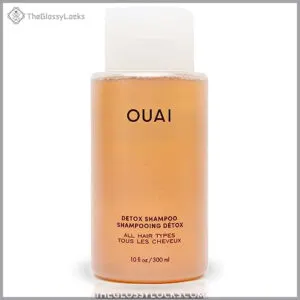
If product buildup has been weighing your hair down, a clarifying shampoo like OUAI Detox might be your weekly reset. This detox shampoo uses apple cider vinegar and chelating agents to strip away buildup, hard water minerals, and chlorine, leaving your scalp health restored and your hair voluminous.
Use it once or twice a week for best results—too frequent washing can strip moisture. The Melrose Place scent divides opinion, so consider that before buying.
At $34, it’s pricey for the bottle size, but reviews confirm noticeable improvements in shine, softness, and reduced frizz, making it a smart addition to your hair products rotation.
Best For: Anyone dealing with product buildup, hard water damage, or an itchy, flaky scalp who wants a weekly deep-cleanse reset.
- Effectively removes stubborn buildup, hard water minerals, and chlorine while restoring volume and shine
- Sulfate-free and gentle enough for chemically treated, curly, and color-treated hair
- Noticeably improves hair softness, reduces frizz, and helps with scalp health issues like itchiness
- Expensive at $34 for a relatively small bottle, especially for a product meant for weekly use
- The Melrose Place scent can be polarizing—some find it too strong or unappealing
- Not a daily shampoo and won’t completely solve chronic oiliness on its own
3. Curlsmith Curl Quenching Conditioning Wash
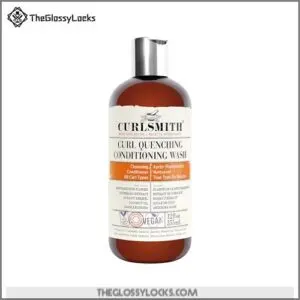
For wavy to coily textures, cowashes like Curlsmith’s Curl Quenching Conditioning Wash offer a gentler cleansing option. This sulfate-free formula uses shea butter, aloe, and coconut oil to moisturize while removing buildup, making it perfect for maintaining scalp health without stripping natural oils.
Users praise its ability to boost curl definition and detangle in one step, with user satisfaction consistently high. While the 355ml bottle feels small at its price point, ingredient analysis reveals quality hydrators that outperform traditional shampoos.
Its comparative advantages include reducing frizz and replacing multiple products, though some curly hair types may still need occasional clarifying treatments.
Best For: Wavy to coily hair types seeking a gentle, sulfate-free alternative to traditional shampoo that cleanses, moisturizes, and defines curls in one step.
- Cleanses without stripping natural oils while boosting curl definition and reducing frizz, making it ideal for maintaining healthy curls between wash days
- Multi-purpose formula replaces both shampoo and conditioner, detangling hair while nourishing with shea butter, aloe, and coconut oil
- Curly Girl Method approved and completely free from sulfates, silicones, mineral oils, and phthalates, with a pleasant natural scent
- Higher price point compared to drugstore alternatives, and the 355ml bottle may feel small for the cost
- May require occasional use of a clarifying shampoo for complete buildup removal, as it’s not designed for deep cleansing
- Some users report packaging issues like broken dispensers, and the scent might be too strong for sensitive preferences
4. VEGAMOUR GRO Scalp Detox Serum
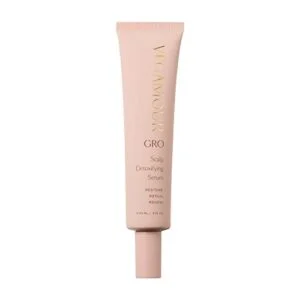
Beyond gentle cleansing, detoxing scalp serums target deeper issues like scalp buildup and irritation. VEGAMOUR’s GRO Scalp Detox Serum uses zinc PCA and wild-harvested baobab oil to balance oil production and soothe inflammation. Its clinical efficacy demonstrates a notable 58% reduction in buildup after just 15 days.
Dandruff reduction was observed in as little as three days among study participants, while consumer reviews boast an impressive 4.7-star average from 216 users. The vegan, cruelty-free formula promotes both hair growth and scalp health, though its 2-ounce size may seem pricey to some.
Scalp serum benefits extend to removing impurities without stripping moisture, making it an ideal solution for maintaining scalp balance between washes.
Best For: Anyone dealing with scalp buildup, excess oil, or dandruff who wants a clean, vegan formula with clinically proven results.
- Clinical studies show 58% reduction in scalp buildup after 15 days and visible dandruff improvement within 3 days
- Clean, vegan formula with zinc PCA and wild-harvested oils that balances sebum without stripping moisture
- High customer satisfaction with 4.7-star rating from 216 reviews and recognition as a Women’s Health award winner
- Small 2-ounce bottle size at $42 may not last long with regular use
- Watery texture can be tricky to apply and massage into dry hair
- May leave hair feeling dry if not paired with proper conditioning
5. Nécessaire Rosemary Hair Serum for Thinning
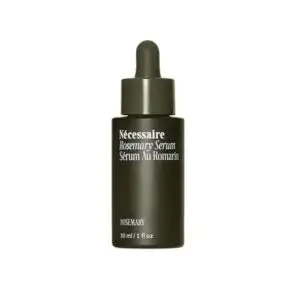
If you’re targeting hair thinning, Nécessaire’s Rosemary Hair Serum brings impressive clinical results to the table. With 70% rosemary blend and 5% Capixyl, this vegan serum fosters hair growth while calming inflammation.
In a 90-day study, 70% of users saw improved density, 74% noticed fuller hair, and 77% experienced stronger strands. The lightweight formula absorbs quickly, leaving no residue, and works for all hair types.
At $48 for 30ml, it’s a premium investment in scalp health and fighting hair loss—ideal if you want a natural, hair care product backed by science.
Best For: Anyone dealing with noticeable thinning or hair loss who wants a clinically-backed, natural serum that actually delivers measurable results.
- Strong clinical data showing 70% of users saw improved density and 74% noticed fuller hair after 90 days of daily use
- High-quality formula with 70% rosemary blend and 5% Capixyl, plus it’s vegan, dermatologist-tested, and free from harsh chemicals
- Lightweight, quick-absorbing texture that leaves no greasy residue and works for all hair types
- Pricey at $48 for just 30ml, which might be a stretch if you’re on a budget
- Small bottle size means you could burn through it quickly, especially if you have thicker or longer hair
- Takes consistent daily use over months to see real results, so it requires patience and commitment
6. Nutrafol Women’s Hair Growth Serum
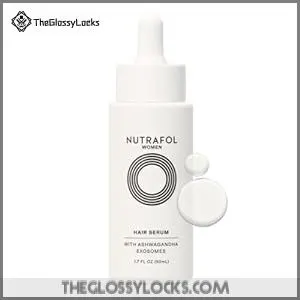
Nutrafol Women’s Hair Growth Serum uses Ashwagandha Exosomes and Pea Sprout Extract to tackle hair thinning at the root. Its targeted mechanism tackles stress-related cortisol and DHT, two major contributors to hair loss.
Clinical efficacy is solid: 84% of users saw less shedding, and 90% experienced improved hair health within six months. The lightweight formula absorbs fast, making daily scalp application easy.
Usage guidelines suggest applying once daily for at least three months to see results. At $69, it’s a premium hair care product with strong market impact, backed by science and over 1.5 million users worldwide.
Best For: Women experiencing stress-related hair thinning or hormonal hair loss who want a clinically-backed topical serum with natural ingredients and are willing to commit to daily use for 3-6 months.
- Clinical results show 84% of users experienced less shedding and 90% saw improved hair health within six months, with statistically significant increases in hair count and density.
- Patent-pending Ashwagandha Exosomes target stress-related cortisol and DHT while lightweight formula absorbs quickly without residue, making daily scalp application easy.
- Vegan, sulfate-free, paraben-free, and silicone-free formula uses natural ingredients like Irish Moss Peptides and Pea Sprout Extract to strengthen hair and reduce breakage.
- Premium price point at $69 for 1.7 fl oz may be prohibitive for budget-conscious buyers, especially considering the need for consistent long-term use.
- Results require patience, with visible changes typically appearing only after 8-10 weeks of daily application, reflecting the natural hair growth cycle.
- Not suitable for pregnant women or those on blood-thinning medications, and the fine glass applicator requires careful handling to avoid breakage.
7. K18 Molecular Repair Hair Oil
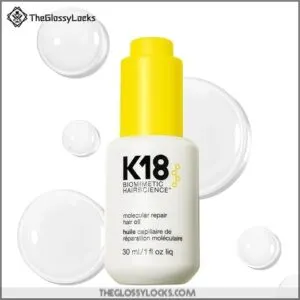
K18 Molecular Repair Hair Oil leverages peptide technology to reconnect broken bonds within the hair cortex, addressing hair damage at the molecular level. This application protocol makes certain the K18PEPTIDE penetrates beyond the cuticle for internal repair.
Apply 1–3 drops to towel-dried hair, wait four minutes for peptide activation, then style as usual. Heat protection up to 450°F safeguards strands during styling, while frizz reduction comes from sealed cuticles and balanced moisture.
Consumer reviews highlight decreased breakage and softer ends after consistent use. Among hair care products, it stands out for hair conditioning and hair protection, supporting overall hair health with a concentrated, lightweight formulation.
Best For: Anyone with damaged, chemically treated, or frizz-prone hair looking for molecular-level repair with heat protection up to 450°F.
- Repairs broken bonds at the molecular level with bioactive peptide technology that penetrates deep into the hair cortex
- Provides heat protection up to 450°F while reducing frizz and enhancing shine with just 1–3 drops
- Long-lasting formula requires minimal product per use, making the bottle last months despite the $65 price point
- Expensive at $65 for 1 fluid ounce, which may not fit every budget
- Results can vary, with some users reporting minimal improvement, especially those with fine or overprocessed hair
- Can leave residue or not layer well with other styling products if application amount isn’t precise
8. Christophe Robin Prickly Pear Serum
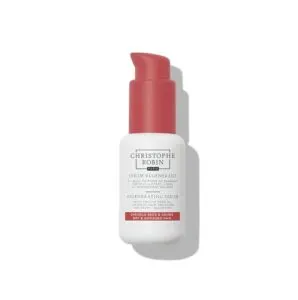
Christophe Robin Prickly Pear Serum combines 94% natural-origin ingredients to deliver lightweight nourishment without silicones. Prickly pear benefits include omega fatty acids and antioxidants that support damaged hair repair, while tucuma butter and castor oil seal split ends and boost shine.
This vegan haircare formula offers serum heat protection up to 440°F, making it essential among hair oils for preventing hair damage during styling.
Apply a pea-sized amount to damp or dry hair—mid-lengths to ends—for frizz control and a mirror-like finish. The lightweight texture won’t weigh down fine strands, and daily use improves manageability across all hair types.
Best For: Anyone with damaged, dry, or frizz-prone hair who wants lightweight heat protection and shine without silicones or heavy buildup.
- Protects hair from heat up to 440°F while sealing split ends and boosting shine with natural ingredients like prickly pear oil and castor oil
- Lightweight, fast-absorbing formula won’t weigh down fine hair and works on damp or dry strands for versatile styling
- Vegan, cruelty-free, and free from silicones, parabens, sulfates, and mineral oils—ideal for clean beauty fans
- Expensive at $49 for only 1.6 ounces, which may not last long with daily use
- Small bottle size might feel limiting for those with thick or long hair who need more product
- Prickly pear scent could be too strong for users sensitive to fragrance
9. Kerastase Overnight Hair Serum Dry Hair
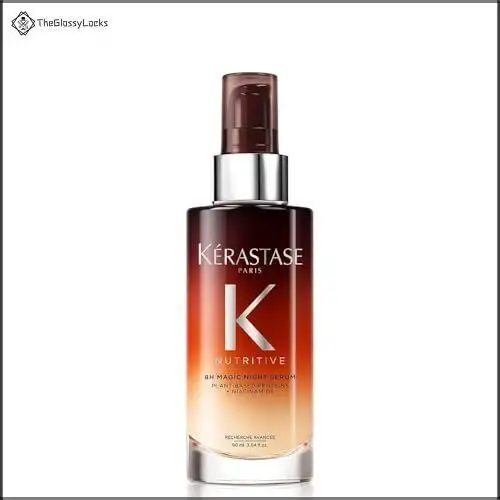
Kérastase Nutritive 8H Magic Night Serum transforms dry hair while you sleep, releasing plant-based proteins and niacinamide over eight hours for continuous overnight hydration. This hair care innovation addresses hair dryness with iris root extract, five vitamins, and a paraben-free formula that absorbs without transferring onto your pillow.
Apply three to four pumps to damp or dry hair from mid-lengths to ends—no morning rinse needed. Clinical tests show 98% greater softness after one week, and users report smoother texture with 95% less brittleness.
The serum ingredients strengthen each strand, reduce frizz, and deliver visible shine by morning, making it a top performer in performance outcomes and market analysis for overnight hair oils targeting hair damage.
Best For: People with dry, brittle, or frizz-prone hair who want overnight nourishment without morning rinsing or pillow residue.
- Delivers measurable results with 98% greater softness after one week and continuous 8-hour nutrient release while you sleep.
- No-rinse formula absorbs completely without transferring to pillowcases, making it convenient for nightly use.
- Paraben-free formulation with plant proteins, niacinamide, and iris root extract strengthens hair and reduces frizz noticeably by morning.
- Premium price point at $62 for 90mL may not fit every budget, especially for a product requiring regular use.
- Floral scent might be too strong for users sensitive to fragrances or who prefer unscented hair products.
- Best results require consistent nightly application, which may not suit those looking for occasional or quick-fix treatments.
10. Mizani Heat Protectant Spray for Hair
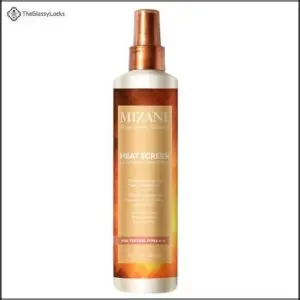
Mizani Style Shifter Society Heat Screen shields your strands up to 450°F, making it a reliable partner for flat irons, blow dryers, and curling wands. This thermal spray application works on texture types 8–4, delivering lightweight coverage without sticky buildup.
You’ll spray it on damp hair from ends to scalp, keeping the bottle six to eight inches away for even distribution. The formula combines rose water, glycerin, and cannabis sativa seed oil for moisture balance during heat styling, while tea tree and peppermint oils refresh your scalp.
Tests show 30–40% frizz reduction and up to 50% less hair damage compared to untreated strands, plus shine that lasts two days in humid weather. At around $22 for 8.5 ounces, it sits comfortably in the mid-tier heat protectant market, earning spots on top-15 lists and a 70% repeat purchase rate among users who notice stronger, smoother results.
Best For: Anyone with textured, frizzy, or heat-styled hair (types 8–4) who needs reliable thermal protection up to 450°F without heavy buildup.
- Protects hair up to 450°F while reducing frizz by 30–40% and damage by up to 50% compared to untreated hair
- Lightweight mist formula with tea tree, peppermint, and cannabis seed oils won’t weigh down curls or leave residue
- Works across multiple styling tools and maintains shine for up to 48 hours, even in humidity
- Some users report a sticky film on hair after application
- May not satisfy those who prefer separate heat protectant and finishing spray products
- Price point around $22–$26 might be higher than budget alternatives
Frequently Asked Questions (FAQs)
How often should I replace my hairbrush?
Like a well-loved pair of shoes that eventually wears out, your hairbrush needs replacing too.
Generally, swap it every six to twelve months, depending on bristle condition, cleaning frequency, and usage habits. Regular brush maintenance protects hair health and prevents hair breakage.
Can I repair severely damaged hair without cutting?
Bond-building treatments with protein and hydration can improve hair damage, split ends, and hair breakage. Patience and consistency matter, though severe damage often needs trimming.
Hair care products with damage repair ingredients work, but watch for protein overload risks.
What causes hair static and how to prevent it?
Static happens when humidity levels drop and friction builds up, especially in dry air.
You can prevent hair static by using moisturizing hair care products, switching to natural comb materials, and trying DIY solutions like leave-in conditioner to combat hair dryness and frizz.
Should I brush wet or dry hair first?
Ever yanked a brush through sopping wet strands only to watch clumps fall into the sink? It’s heartbreaking.
Always detangle dry hair first with a wide-tooth comb to minimize hair breakage and damage from wet hair weakness.
How do I choose the right shampoo for my scalp type?
Start by identifying your scalp type—oily, dry, or balanced. Look for a sulfate-free formula with ingredients suited to your needs.
Check product reviews and pH balance info. For oily hair, try clarifying shampoo; for dry hair, choose hydrating options.
Conclusion
Here’s a wild thought: maybe your hair wasn’t the problem all along—you were just treating it like someone else’s. The right hair care and styling advice isn’t about chasing flawlessness; it’s about learning what your hair actually needs and giving it that.
Stop copying routines that weren’t built for you. Start listening to your texture, your scalp, your lifestyle. When you finally work with your hair instead of against it, everything clicks.
No more guessing, no more frustration—just hair that feels like yours.
- https://www.grandviewresearch.com/industry-analysis/hair-care-market
- https://pmc.ncbi.nlm.nih.gov/articles/PMC4852869
- https://jamanetwork.com/journals/jamadermatology/fullarticle/2820685
- https://www.dyson.com/discover/innovation/research-partners/dyson-global-hair-study
- https://www.aad.org/public/skin-hair-nails/hair-care/tips-for-healthy-hair

